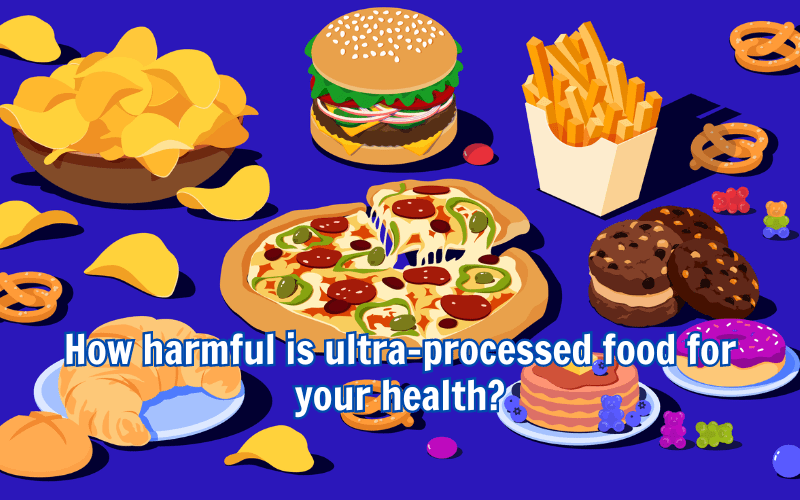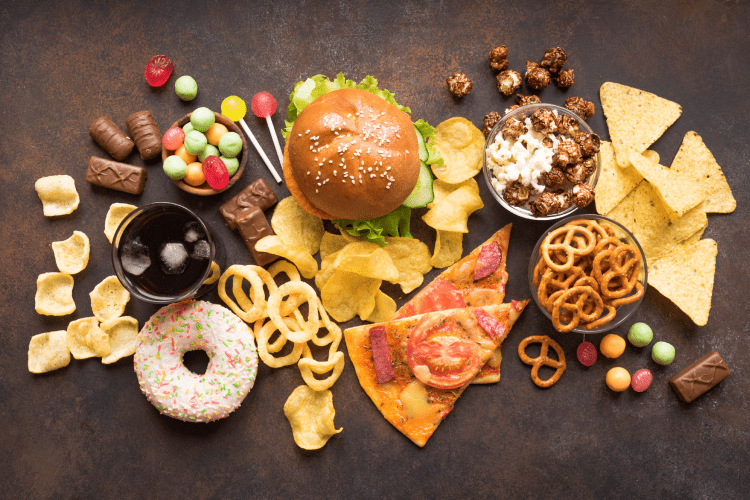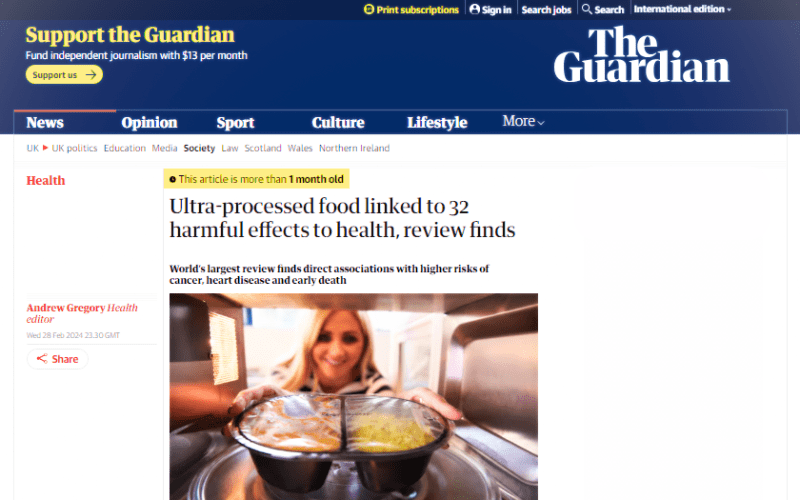What is ultra-processed food? How does it affect health?
In today’s modern food landscape, the term “ultra-processed food” has become increasingly prevalent, sparking discussions and debates about its impact on health. As we navigate through aisles lined with brightly colored packaging and seemingly endless options, it’s crucial to understand what exactly constitutes ultra-processed food and the implications it holds for our well-being. From convenience meals to sugary snacks, these heavily processed products have permeated our diets, raising questions about their nutritional value and potential health risks. In this article, we delve into the concept of ultra-processed food, exploring its defining characteristics and examining the mounting evidence regarding its effects on health. Join GOL Solutions on a journey to uncover the truth behind the allure of ultra-processed foods and the profound implications they carry for our bodies and overall health.
What is ultra-processed food?
Ultra-processed foods have become a significant aspect of modern diets, yet their definition and implications might not be immediately clear. To comprehend the essence of ultra-processed foods, it’s vital to delve into their composition, production processes, and their impact on health and society.

The food classification system divides food into four categories based on the degree of processing they undergo during production:
- Unprocessed or minimally processed foods: This category encompasses natural foods like fruits, vegetables, milk, fish, pulses, eggs, nuts, and seeds. These foods have undergone minimal alteration from their natural state and typically contain no added ingredients.
- Processed ingredients: This includes individual ingredients that are added to other foods during preparation, such as salt, sugar, and oils. These ingredients are not typically consumed on their own but are used in cooking and food preparation.
- Processed foods: Foods in this category are made by combining ingredients from both the unprocessed/minimally processed category and processed ingredients. Examples include jams, pickles, canned fruits and vegetables, homemade bread, and cheeses. These foods undergo some level of alteration during preparation, but the process is similar to what home cooks could do themselves.
- Ultra-processed foods: This category represents the most heavily processed foods, typically containing multiple ingredients that are not commonly found in home kitchens. Ultra-processed foods often include additives and ingredients not typically used in home cooking, such as preservatives, emulsifiers, sweeteners, and artificial colors and flavors. These foods also tend to have a long shelf life. Common examples of ultra-processed foods include ice cream, processed meats (like ham and sausages), crisps, mass-produced bread, breakfast cereals, biscuits, carbonated drinks, fruit-flavored yogurts, instant soups, and certain alcoholic beverages like whisky, gin, and rum.
The production of ultra-processed foods involves industrial techniques aimed at maximizing efficiency and profitability. These foods are often manufactured in large-scale facilities where raw ingredients are transformed through processes like extrusion, hydrogenation, and chemical alteration. Such methods not only strip away the natural properties of the ingredients but also introduce harmful compounds and by-products into the final products.
The addictive nature of ultra-processed foods can make them challenging to resist, leading to overconsumption and subsequent health issues. The combination of refined ingredients, artificial additives, and palatable flavors stimulates the reward centers in the brain, promoting cravings and compulsive eating behaviors. This cycle of consumption can perpetuate poor dietary habits and exacerbate the risk of chronic diseases over time.
So, while unprocessed and minimally processed foods are closest to their natural state and typically contain only one ingredient, ultra-processed foods undergo extensive processing and contain numerous additives, making them less nutritious choices.
How harmful is ultra-processed food for your health?
Ultra-processed foods have become ubiquitous in modern diets, filling grocery store shelves and dominating fast-food menus. However, their convenience and affordability come at a cost to our health. Research increasingly suggests that the consumption of ultra-processed foods is linked to a variety of negative health outcomes, making it crucial to understand just how harmful these products can be.

One of the primary concerns surrounding ultra-processed foods is their nutritional profile—or rather, lack thereof. These products are often high in calories, added sugars, unhealthy fats, and sodium, while simultaneously lacking essential nutrients like fiber, vitamins, and minerals. This imbalance can contribute to weight gain, obesity, and a higher risk of chronic diseases such as type 2 diabetes, heart disease, and certain cancers.
Furthermore, the high levels of added sugars and unhealthy fats found in ultra-processed foods can wreak havoc on metabolic health. Excessive sugar consumption, in particular, has been linked to insulin resistance, elevated blood sugar levels, and an increased risk of developing diabetes. Similarly, diets high in unhealthy fats, such as trans fats and saturated fats, can raise cholesterol levels and contribute to cardiovascular problems.
Beyond their poor nutritional quality, ultra-processed foods often contain a myriad of additives and preservatives. These additives serve various purposes, including enhancing flavor, improving texture, and extending shelf life. However, some of these additives have been associated with adverse health effects. For example, certain food dyes and artificial flavors have been linked to hyperactivity in children and may increase the risk of allergic reactions in sensitive individuals. Moreover, preservatives like nitrites and nitrates, commonly found in processed meats, have been linked to an increased risk of cancer.
Another concerning aspect of ultra-processed foods is their potential impact on gut health. These products are often low in fiber, which plays a crucial role in maintaining a healthy digestive system. A diet lacking in fiber can disrupt the balance of bacteria in the gut, leading to issues such as constipation, inflammation, and an increased susceptibility to gastrointestinal diseases.
In addition to their direct effects on physical health, ultra-processed foods may also have implications for mental well-being. Research suggests that diets high in processed and sugary foods may increase the risk of depression and other mental health disorders. The exact mechanisms behind this association are complex and multifaceted but likely involve the interplay between nutrient deficiencies, inflammation, and disruptions in neurotransmitter function.
Furthermore, the addictive nature of certain ultra-processed foods can contribute to problematic eating behaviors and food cravings. These products are often engineered to be highly palatable, triggering reward pathways in the brain that can lead to overconsumption and difficulties with portion control. This cycle of overeating can perpetuate unhealthy eating habits and contribute to weight gain and obesity.
It’s essential to recognize that the harm caused by ultra-processed foods extends beyond individual health outcomes and has broader societal implications. The consumption of these products contributes to the global burden of disease, placing strain on healthcare systems and economies worldwide. Additionally, the production and marketing of ultra-processed foods often perpetuate inequalities in access to healthy food options, disproportionately affecting marginalized communities with limited resources.
A compilation of common ultra-processed foods

Here’s a compilation of common ultra-processed foods:
- Ice Cream: This beloved dessert typically contains a plethora of additives, including artificial flavors, colors, and sweeteners, along with high levels of sugar and unhealthy fats.
- Ham and Sausages: Processed meats like ham and sausages often undergo extensive processing, including curing, smoking, and addition of preservatives, making them high in sodium and potentially harmful additives.
- Crisps (Potato Chips): These crispy snacks are often loaded with unhealthy fats, sodium, and artificial flavors and colors to enhance their taste and appearance.
- Mass-Produced Bread: Commercially produced bread often contains additives and preservatives to extend its shelf life, along with refined flours and added sugars.
- Breakfast Cereals: Many breakfast cereals are heavily processed and contain high amounts of added sugars, artificial flavors, and colors, making them a poor choice for a nutritious breakfast option.
- Biscuits (Cookies): These sweet treats are typically made with refined flours, sugars, and unhealthy fats, along with artificial flavors and preservatives to enhance their taste and shelf life.
- Carbonated Drinks: Sodas and other carbonated beverages are loaded with added sugars or artificial sweeteners, along with various artificial flavors and colors.
- Fruit-Flavored Yogurts: While yogurt itself can be a healthy choice, fruit-flavored varieties often contain high amounts of added sugars, artificial flavors, and colors, negating their potential health benefits.
- Instant Soups: Packaged instant soups are convenient but often contain high levels of sodium, preservatives, and artificial flavors, with little nutritional value.
- Some Alcoholic Drinks: Certain alcoholic beverages, such as pre-mixed cocktails and flavored spirits, may contain added sugars, artificial flavors, and colors, especially in mass-produced varieties.
These examples illustrate the wide range of ultra-processed foods commonly found in the modern diet. Their consumption should be limited in favor of whole, minimally processed foods to promote better health and well-being.
What does the FDA say about ultra-processed food?
In an effort to enhance nutritional standards and combat the prevalence of chronic diseases, the FDA has introduced guidelines aimed at encouraging the food industry to voluntarily reduce sodium levels in processed and packaged foods. Recognizing the rising tide of preventable health issues such as cardiovascular disease, diabetes, and obesity, the FDA is intensifying its focus on promoting healthier dietary habits.
The finalized guidance titled ‘Voluntary Sodium Reduction Goals’ delineates short-term targets for sodium reduction across 163 categories of processed, packaged, and prepared foods. This initiative aligns with the government’s comprehensive approach to improving nutrition and public health outcomes.
Reducing sodium intake can significantly mitigate health risks, particularly for marginalized communities disproportionately affected by conditions like hypertension. The ongoing COVID-19 pandemic has underscored the urgency of addressing these health disparities, as individuals with pre-existing conditions face heightened susceptibility to severe outcomes.
Statistics reveal that individuals consume sodium in excess of recommended levels, with children particularly vulnerable. Given that a significant portion of sodium intake stems from packaged, processed, and restaurant foods, altering the composition of these food sources can facilitate healthier dietary choices without necessitating behavioral changes.
The established targets aim to reduce average sodium intake by approximately 12% over the next 2.5 years. While this would still exceed the recommended limit outlined in the Dietary Guidelines for Americans, even modest reductions can yield substantial improvements in public health outcomes.
The FDA encourages prompt action from the food industry to meet these short-term goals, with plans to reassess and potentially revise targets in the future. This iterative approach ensures a gradual reduction in sodium levels across the food supply, allowing for consumer adaptation and improved health outcomes.
While progress has been made since the initial proposal in 2016, broader support and engagement across all sectors of the food industry are imperative. Consumers can also play a role by making informed choices, utilizing nutrition labels, and advocating for healthier options.
The FDA remains steadfast in its commitment to fostering a healthier food environment and empowering consumers to make informed dietary decisions. Collaborative efforts among governmental, organizational, and individual stakeholders hold the potential to affect meaningful change and improve the health and well-being of millions.

Read more: What is FDA QSR? Differences between FDA QSR and ISO 13485
Latest research findings on the impact of ultra-processed food on health
The latest research findings on the impact of ultra-processed food (UPF) on health reveal a concerning array of detrimental effects (this article is more than 1 month old). This comprehensive review, the largest of its kind to date, has unearthed a staggering 32 harmful outcomes associated with UPF consumption, ranging from heightened risks of heart disease, cancer, and type 2 diabetes to adverse impacts on mental health and increased mortality rates.
In an era of escalating global consumption of UPF, including items such as cereals, protein bars, fizzy drinks, ready meals, and fast food, these findings are particularly pertinent. Alarmingly, in countries like the UK and US, where UPF intake is rampant, more than half of the average diet comprises these heavily processed foods. Among certain demographics, such as younger individuals, those from lower socioeconomic backgrounds, or residents of disadvantaged areas, UPF consumption can soar to as high as 80% of their diet.
Published in the esteemed BMJ, this research underscores the urgent need for interventions aimed at reducing exposure to UPF. Drawing on data from nearly 10 million individuals, the study highlights the pervasive negative impact of UPF on various aspects of health, prompting calls for targeted measures to curb its consumption.
Conducted by experts from prestigious institutions such as Johns Hopkins Bloomberg School of Public Health, the University of Sydney, and Sorbonne University, the review represents a milestone in understanding the health implications of UPF. It consolidates evidence from 45 pooled meta-analyses across 14 review articles, providing a comprehensive overview of the association between UPF consumption and adverse health outcomes.

The findings reveal a consistent link between higher UPF intake and elevated risks of numerous health conditions. Convincing evidence points to a 50% increased risk of cardiovascular disease-related death, as well as significant correlations with anxiety, common mental disorders, and type 2 diabetes. Moreover, highly suggestive evidence implicates UPF consumption in a host of other health concerns, including obesity, depression, and sleep problems.
Despite the robustness of the findings, the researchers acknowledge certain limitations inherent in the study, including potential confounding variables and variations in UPF assessment methods. Moreover, experts caution against inferring causation from these associations, noting the predominantly observational nature of the research.
Nevertheless, the implications of these findings are profound. Dr. Chris van Tulleken, an esteemed expert on UPF, emphasizes the consistency of these results with existing literature, pointing to the well-established mechanisms through which UPF contributes to poor health outcomes. Beyond their nutritional shortcomings, UPF’s aggressive marketing and engineered palatability drive excessive consumption, particularly among vulnerable communities.
In parallel, another study published in the Lancet Public Health underscores the potential benefits of public health interventions targeting food environments. By mandating calorie labeling in restaurants, fast food outlets, cafes, pubs, and takeaways, England could avert thousands of heart disease-related deaths over the next two decades.
In conclusion, the latest research paints a stark picture of the detrimental effects of UPF on health. Urgent action is needed to mitigate the pervasive influence of these heavily processed foods and promote healthier dietary habits, with far-reaching implications for public health and well-being.
Frequently Asked Questions (FAQs)
Why are ultra-processed foods considered unhealthy?
Ultra-processed foods are often high in added sugars, unhealthy fats, and sodium, while lacking essential nutrients like fiber, vitamins, and minerals. Regular consumption of these foods has been linked to obesity, cardiovascular disease, type 2 diabetes, and other chronic health conditions.
How can I identify ultra-processed foods?
Ultra-processed foods are typically found in the inner aisles of grocery stores and often come in brightly colored packaging with long ingredient lists containing unfamiliar additives and preservatives. They tend to have a long shelf life and are convenient for quick consumption.
What are the health risks associated with consuming ultra-processed foods?
Regular consumption of ultra-processed foods has been associated with an increased risk of obesity, high blood pressure, heart disease, type 2 diabetes, certain cancers, and adverse effects on mental health. These foods are often high in calories and low in nutritional value, leading to poor overall health outcomes.
How do ultra-processed foods differ from minimally processed foods?
Minimally processed foods, such as fresh fruits, vegetables, and whole grains, undergo minimal alteration from their natural state and contain no added ingredients. In contrast, ultra-processed foods are heavily processed and often contain added sugars, unhealthy fats, and artificial additives.
Can I still eat ultra-processed foods occasionally?
While occasional consumption of ultra-processed foods is not likely to cause significant harm, it’s important to maintain a balanced approach to your diet. Whole, minimally processed foods should be prioritized as the foundation of your meals and snacks. These foods, including fruits, vegetables, whole grains, lean proteins, and healthy fats, provide essential nutrients and contribute to better overall health and well-being.
Ultra-processed foods, on the other hand, tend to be high in unhealthy fats, sugars, and sodium, while lacking important nutrients. Consuming them in moderation is acceptable, but they should not form the bulk of your diet. Instead, reserve them for special occasions or occasional treats.
By focusing on whole, minimally processed foods, you can ensure that your body receives the nutrients it needs to thrive while minimizing the potential negative effects associated with excessive consumption of ultra-processed foods. This balanced approach can support your long-term health and well-being.
How can I reduce my intake of ultra-processed foods?
Reducing your intake of ultra-processed foods can be achieved by adopting several strategies:
- Cook at Home: Prepare meals at home using fresh, whole ingredients whenever possible. By cooking from scratch, you have greater control over the ingredients and cooking methods used, reducing reliance on processed products.
- Choose Whole Foods: When grocery shopping, prioritize minimally processed foods such as fruits, vegetables, whole grains, and lean proteins. These nutrient-rich options form the foundation of a healthy diet and can help decrease reliance on ultra-processed alternatives.
- Read Food Labels: Become a savvy label reader and scrutinize the ingredient lists and nutrition labels of packaged foods. Avoid products containing added sugars, unhealthy fats (such as trans fats), and artificial ingredients like preservatives, flavor enhancers, and colorings. Opt for products with shorter ingredient lists and recognizable, whole-food ingredients.
- Limit Convenience Foods: Minimize reliance on convenience foods such as ready-to-eat meals, snack bars, and pre-packaged snacks, as these often contain high levels of additives, preservatives, and unhealthy fats. Instead, prepare homemade versions or choose healthier alternatives.
- Plan and Prepare: Plan your meals and snacks ahead of time to avoid resorting to ultra-processed options out of convenience. Batch cooking and meal prepping can streamline the process of preparing nutritious meals and snacks, making it easier to stick to whole-food choices throughout the week.
- Practice Mindful Eating: Be mindful of your eating habits and the cues that trigger consumption of ultra-processed foods, such as stress, boredom, or convenience. Develop alternative coping mechanisms and habits that support healthier choices, such as taking a walk, practicing relaxation techniques, or preparing nutritious snacks in advance.
- Gradual Transition: Transitioning away from ultra-processed foods may take time, so be patient with yourself and focus on making gradual changes to your diet. Start by replacing one ultra-processed item with a whole-food alternative each week, gradually increasing the proportion of whole foods in your diet over time.
By implementing these strategies and adopting a mindful approach to food choices, you can successfully reduce your intake of ultra-processed foods and cultivate a healthier eating pattern for long-term well-being.
Can ultra-processed foods be part of a balanced diet?
Absolutely, incorporating ultra-processed foods occasionally into your diet isn’t inherently harmful, but they shouldn’t constitute a significant portion of your daily intake. Prioritizing whole, minimally processed foods rich in nutrients ensures that you’re meeting your body’s needs for optimal health and well-being. Restricting the consumption of ultra-processed foods helps maintain a balanced diet and reduces the risk of potential adverse health effects associated with their regular intake.
How can I distinguish between processed and ultra-processed foods when grocery shopping?
Distinguishing between processed and ultra-processed foods while grocery shopping requires a keen eye for labels and packaging:
- Processed Foods: These items undergo some degree of processing but still maintain a considerable portion of their nutritional value. Examples include canned fruits and vegetables, whole-grain bread, plain yogurt, and minimally processed meats. They often have shorter ingredient lists, with recognizable, whole-food ingredients.
- Ultra-Processed Foods: In contrast, ultra-processed foods undergo extensive processing and often contain additives, preservatives, and artificial flavorings. They typically come in brightly colored packaging and are prominently displayed in the inner aisles of grocery stores. Examples include sugary breakfast cereals, pre-packaged snacks, frozen meals, and sweetened beverages. Ingredient lists for ultra-processed foods tend to be long and contain unfamiliar or artificial ingredients.
When grocery shopping, opt for whole, minimally processed foods as much as possible and be cautious when selecting processed or ultra-processed items. Reading food labels can provide valuable insights into the level of processing and the quality of ingredients used in packaged foods, helping you make informed choices for a healthier diet.
Recognizing the urgency of addressing the prevalence of ultra-processed foods, regulatory bodies like the FDA have taken steps to provide guidance and support.Through collaborative efforts between government agencies, industry stakeholders, and public health advocates, progress can be made in reducing the consumption of ultra-processed foods and improving overall dietary patterns.
Summary
In summary, ultra-processed foods are an integral part of modern diets, but their high content of unhealthy additives and low nutritional value can significantly impact health. Understanding the risks associated with these foods can empower consumers to make healthier dietary choices and potentially mitigate the adverse effects on health such as obesity, heart disease, and diabetes.
For businesses in the food industry, ensuring products meet safety and quality standards is crucial, especially when navigating the complexities of FDA compliance. GOL Solution is here to help. With a track record of serving over 5000+ companies with trade compliance and supply chain management solutions, GOL offers specialized services including FDA Registration and FDA Food Registration. Whether you’re looking to ensure your food products comply with the latest FDA regulations or need expert guidance in managing your product registrations, GOL provides the support you need to keep your business both competitive and compliant.
To explore how GOL can assist in enhancing your compliance processes or to get started with your FDA registration today, reach out to us at clients@golsolution.com or call our hotline at +65 8342 6900. Let us help you navigate the regulatory landscape and support your journey towards offering safer, healthier food products to the market.



